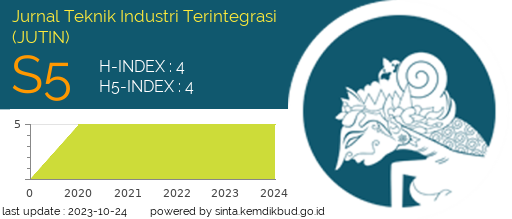Analisis Peramalan Demand Produk RBL dengan Metode Double Exponensial Smoothing, Moving Avarage, dan Regresi Linear di PT Seiwa Indonesia
DOI:
https://doi.org/10.31004/jutin.v7i1.24763Abstract
Based on historical data on the number of product requests and products produced in the January 2021-December 2022 period, there is a considerable discrepancy. Therefore to be able to predict demand in one or several subsequent periods based on past product demand data, the researcher conducts a forecasting analysis using the double exponential smoothing, moving average, and linear regression methods to find out the most accurate forecasting method to use. Based on the calculation results, it can be concluded that the most appropriate Forecasting method is the linear regression method because it has the lowest MSE value of 1,346,936,387. It is hoped that it will be able to assist PT Seiwa Indonesia in providing future stocks of RBL products in more accurate manner so as to reduce losses due to excessive production.References
Afifah Muhartini, A., Sahroni, O., Dwi Rahmawati, S., Febrianti, T., Mahuda, I., Saintek, F., & Bina Bangsa, U. (2021). ANALISIS PERAMALAN JUMLAH PENERIMAAN MAHASISWA BARU DENGAN MENGGUNAKAN METODE REGRESI LINEAR SEDERHANA (Vol. 1, Issue 1). http://bayesian.lppmbinabangsa.id/index.php/home
Anisya Ramdani, D., Fahriza Nurul Azizah, dan, Karawang Jl Ronggo Waluyo, S. H., Tim, K., & Karawang, K. (2020). EXPONENTIAL SMOOTHING DAN NAIVE METHOD (Comparative Analysis of XYZ Company Lubricant Demand Forecasting with The Moving Average Method, Exponential Smoothing and Naive Method). Seminar NasionalOfficial Statistics 2019:Pengembangan Official Statistics Dalam Mendukung Implementasi SDG’s, 1000–1011.
Hassyddiqy, H., & Hasdiana, H. (2023). Analisis Peramalan (Forecasting) Penjualan Dengan Metode ARIMA (Autoregressive Integrated Moving Average) Pada Huebee Indonesia. Data Sciences Indonesia (DSI), 2(2), 92–100. https://doi.org/10.47709/dsi.v2i2.2022
Indah, D. R., & Rahmadani, E. (2018). Sistem Forecasting Perencanaan Produksi dengan Metode Single Eksponensial Smoothing pada Keripik Singkong Srikandi Di Kota Langsa. JENSI), 2(1), 10–19.
Januardi Ababil, O., Adi Wibowo, S., & Zulfia Zahro, H. (2022). PENERAPAN METODE REGRESI LINIER DALAM PREDIKSI PENJUALAN LIQUID VAPE DI TOKO VAPOR PANDAAN BERBASIS WEBSITE. Jurnal Mahasiswa Teknik Informatika), 6(1).
PT. Seiwa Indonesia. (2021). Data Umum Perusahaan.
Rachman, R., Nusa, S., & Jakarta, M. (2018). Penerapan Metode Moving Averagedan Exponential Smoothingpada Peramalan Produksi Industri Garment. JURNAL INFORMATIKA, 5(1).
Rachmasari Cahyadewi, D., Agung Suryawan, A. W., & Ketut Satriawan, I. (2020). Analisis Peramalan Permintaan dan Pengendalian Persediaan Bahan Baku Body Scrub Powder di CV. Denara Duta Mandiri Demand Forecasting Analysis and Inventory Control of Body Scrub Powder in CV. Denara Duta Mandiri. Jurnal Rekayasa Dan Manajemen Agroindustri , 8(3), 360–368.
Siswanto, E., Satria Wibawa, E., & Mustofa, Z. (2021). Implementasi Aplikasi Sistem Peramalan Persedian Barang Menggunakan Metode Single Moving Average Berbasis Web. 14(2), 224–233. http://journal.stekom.ac.id/index.php/elkom?page224
Sitorus, H., Rosihan, R. I., & Afiat, A. N. (2022). OPTIMASI KAPASITAS PRODUKSI BANTAL DENGAN MENGGUNAKAN INTEGER LINIER PROGRAMMING DI PT. DUNLOPILLO INDONESIA. Jurnal Penelitian Dan Aplikasi Sistem DanTeknik Industri (PASTI), XVI(2), 136–147.
Sukamdani, R. R., Dyah, E. H., & Sutrisno, T. (2020). PERAMALAN DAN PENENTUAN WAKTU PEMESANAN KEMBALI YANG OPTIMAL DENGAN METODE EXPONENTIAL SMOOTHING DAN METODE ECONOMIC ORDER QUANTITY(STUDI KASUS SUMBER MAKMUR). Jurnal Ilmu Komputer Dan Sistem Informasi, 8(02), 291–299.
Downloads
Published
How to Cite
Issue
Section
License
Copyright (c) 2024 Nada Nishi Azizah, Firda Ainun Nisah

This work is licensed under a Creative Commons Attribution-ShareAlike 4.0 International License.





